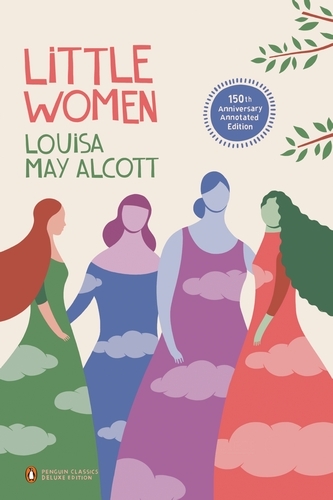This is a repeating event- Event 3 / 519 April 2023 6:00 pm3 May 2023 6:00 pm
Reading Little Women - NEW DATES
Event Details
Undoubtedly one of the most beloved stories ever told, Little
Event Details

Undoubtedly one of the most beloved stories ever told, Little Women has never been out of print since its first publication in 1868. Although set in Massachusetts in the years following the Civil War, it has transcended its time and place and been translated into over fifty languages. Newspapers, radio programmes, podcasts and blogs, from Argentina to Sweden, commemorated the novel’s 150th birthday in 2018. It has been adapted for television from Mexico to Turkey to Japan, and turned into films for the big screen six times (including two early silent films), the most recent being Greta Gerwig’s 2019 Oscar-nominated version.
All of this attention has nonetheless left some wondering “but isn’t it just a sentimental book for girls?” And what about that horrible title? It certainly doesn’t inspire today’s young women to pick it up off the shelf and has also, unfortunately, kept most boys and men from enjoying and learning from its pages. Little Women is not, nor has it ever been, a book just for girls. It is a book about how hard it is to grow up, particularly when society’s expectations for young women and men don’t suit an individual’s nature.
Whatever your gender identity, and whether you’ve never read Little Women, haven’t read it since you were young, or are a long-time fan, you will find much to surprise you as we read it together and discuss its many layers and cultural significance.
By at least two important measures, Little Women is an important book that belongs on the shelf of literary classics. For one, its cultural influence has few parallels, not only in America, but across the globe. Generations of girls, in particular, have read the novel in search of clues to what shape their own lives might take. Meg, Jo, Beth, and Amy have become a shorthand for the kinds of personalities through which girls might make sense of their own.
Jo, especially, has fired the dreams of countless girls hoping to strike out on their own one day and do something exceptional. Readers as varied as Simone de Beauvoir, Patti Smith, the Empress of Japan, Coretta Scott King, J.K. Rowling, and Zadie Smith have all been inspired by Jo March. In far-away 1950s Naples, the two little girls in Elena Ferrante’s My Brilliant Friend (2011) read Little Women “so many times that the book became tattered and sweat-stained, it lost its spine, came unthreaded, sections fell apart.” They decide upon reading it that they will follow Jo and Alcott’s own path and become writers.
Apart from the novel’s cultural influence is also the considerable debate conducted over the past 150 years about how exactly to read Little Women. Is it a realistic tale of a New England family during the years of the Civil War, or a sentimental portrait of a family life that never really existed? Is it a rebellious tale of one young woman’s resistance to the restrictions of her era, or a dispiriting portrait of her capitulation to the status quo? The critic Margo Jefferson has called it “a divided house of a book [that] still stands, ramshackle[,] worn and full of life.” Critics and scholars have disagreed about how traditional or modern the book and its various adaptations really are. Little Women is certainly a book that has caused the kind of “critical commotion” that Jefferson’s fellow critic Alice Kaplan suggests is “one mark of a masterpiece.”
Once we look past the nostalgic glow on the surface of our memories of Alcott’s classic, we can see that the novel raises questions still relevant today. What does it mean that this venerated story of girlhood centres on a girl who doesn’t want to be one at all? How can we aspire to independence and also find love and support in the context of home? And why have so many male readers, from Teddy Roosevelt to John Green, fallen in love with Little Women yet felt they had to hide their affection for it? And what are the implications of the fact that most boys are told that the book is not for them (as they are told about almost all books that focus on girls’ lives)?
One thing to look out for when purchasing the novel is that, due to its publication history, it is still printed in different forms in the U.S. and elsewhere. Originally, in 1868 and 1869, Little Women was published in two volumes, which became one in the U.S. in the years following its great success. But in Britain and the rest of the English-speaking world, the custom continues to publish it in two volumes: Little Women and Good Wives (N.B. Alcott had nothing to do with this title, the second volume in the U.S. was titled Little Women, Part Two).
This study will discuss the entire novel, encompassing both volumes, and we recommend an edition that reprints the original manuscript as Alcott wrote it. Unfortunately, in 1880, the publisher produced a new edition which alters much of the language of the original, robbing it of the vitality of Alcott’s original prose. One indication that you are reading the original text is that you will see the March girls (particularly Jo) using the word “ain’t”, whereas In the revised edition, the word was changed to “am (or is or are) not”.
STUDY DETAILS:
- 5 week virtual study (via Zoom) led by Anne Boyd Rioux (author of Meg, Jo, Beth, Amy: The Story of Little Women and Why It Still Matters)
- Wednesday evenings, 6.00-8.00pm (UK)
- 12 April – 10 May 2023
- £150.00
- Recommended edition: Little Women by Louisa May Alcott, Penguin Classics Deluxe Edition, ISBN: 978-0143106654
Time
26 April 2023 6:00 pm - 8:00 pm(GMT+00:00)
Location
VIRTUAL - VIA ZOOM
